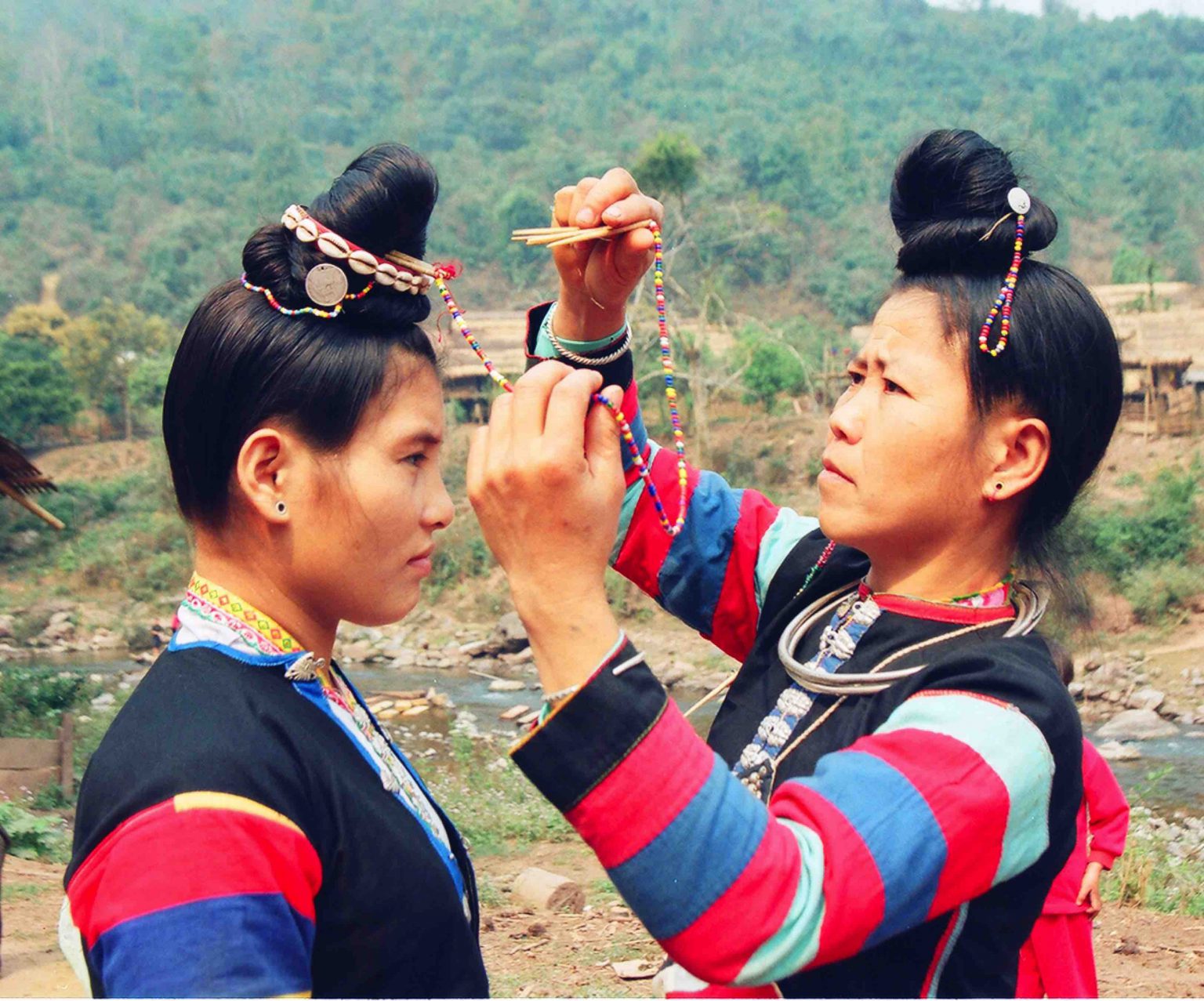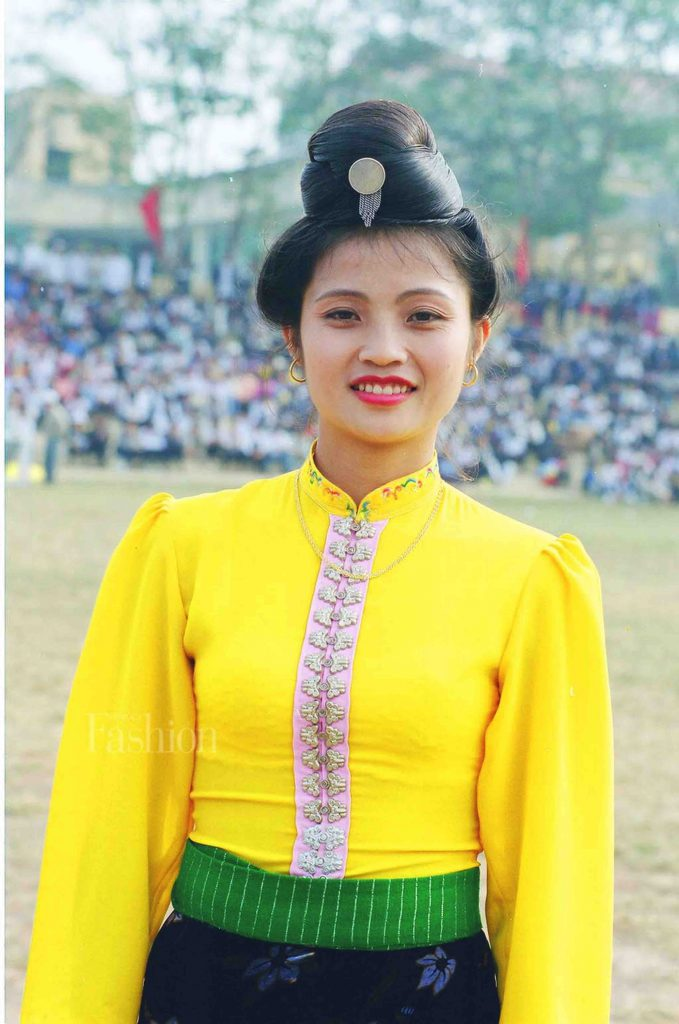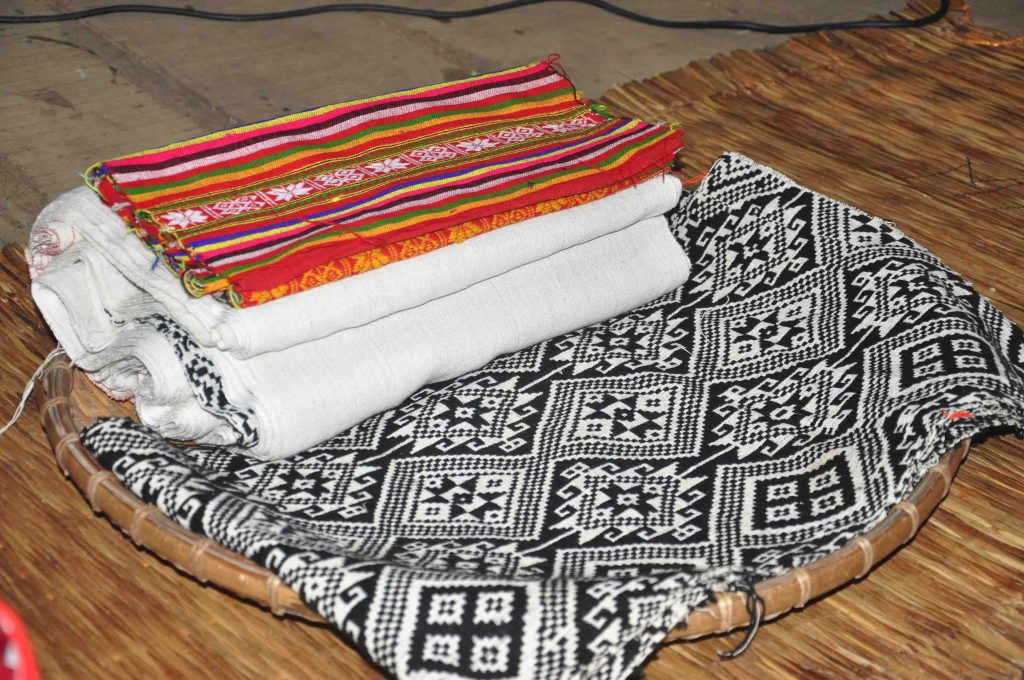
Black Thai Inverted Bun Ceremony
Thai ethnic women have stunning hair. Women are skilled at using natural scents to take care of their hair. When visiting the Thai village in the Northwest, the long, silky hair of the girls near the stream makes an impression. When he got married, he stopped wearing his hair loose and started wearing it in a crane-style bun on top of his head. The wedding ceremony includes an "inverted bun ceremony," which is a particularly solemn bun ceremony.
 The family of the boy visits the family of the girl to request a bun ceremony to accept the bride once they have selected a suitable day (according to the Thai calendar). Before the bride is led in a procession to her husband's home, the inverted bun ritual is performed at the girl's house on the floor in front of the sleeping bride's chamber. The two sides of the family pick two couples to assist in laying out the wedding cushions for the bride and groom once they arrive at the girl's residence at a respectable hour.
The family of the boy visits the family of the girl to request a bun ceremony to accept the bride once they have selected a suitable day (according to the Thai calendar). Before the bride is led in a procession to her husband's home, the inverted bun ritual is performed at the girl's house on the floor in front of the sleeping bride's chamber. The two sides of the family pick two couples to assist in laying out the wedding cushions for the bride and groom once they arrive at the girl's residence at a respectable hour.
The matchmaker positioned pillows and blankets and said: "Oh! Please do the ritual of matching blankets and cushioning for the young couple today; it is a nice day to perform the ceremony of inverted hair for the daughter-in-law ". The ceremonial platter is set up with the dowry from the girl's house and all of the offerings from the boy's house. The boy's offerings included 2 wigs, hair brooches, 1 bun, 1 pair of cushions, 1 pair of blankets, 1 pair of pillows, 1 string, 1 dress, 1 pair of earrings, 1 pair of necklace, and 1 pair of bracelets. The ceremony items at the girl's home included: 1 curtain, 1 mother, 1 pair of mattresses, 1 pair of blankets, 1 pair of pillows, and 1 pair of bracelets.
 One bowl of rice, two chicken eggs, one bowl of water with three pebbles, one tuft of betel grass, and two flowers are also there. The young couple firmly believes in creating a happy household and is always strong in the face of trials and hardships in life, as symbolized by the three tufts of betel grass thrown into a basin of water with three pebbles. Betel grass also represents growth, development, and deep roots. The purpose of the bowl of water with betel sprout grass used to comb the hair is to swiftly grow the hair long, strong, and silky without shedding any hair. Relatives also place small trinkets, jewelry, and occasionally money on the ceremony platter as a blessing for the pair.
One bowl of rice, two chicken eggs, one bowl of water with three pebbles, one tuft of betel grass, and two flowers are also there. The young couple firmly believes in creating a happy household and is always strong in the face of trials and hardships in life, as symbolized by the three tufts of betel grass thrown into a basin of water with three pebbles. Betel grass also represents growth, development, and deep roots. The purpose of the bowl of water with betel sprout grass used to comb the hair is to swiftly grow the hair long, strong, and silky without shedding any hair. Relatives also place small trinkets, jewelry, and occasionally money on the ceremony platter as a blessing for the pair.
 The bride sat down in front of the offering tray as she was brought outside. Comb your daughter's hair down to silk, comb your daughter's hair down to make it beautiful for your daughter to get married, comb my good child's hair, from this moment on you are married, I will not be able to comb my beloved daughter's hair anymore, just wishing you well, listening to your parents-in-law, doing business with your husband, having children, and living together happily..." the mother (or aunt) straightened the bride's hair and combed her hair. The mother-in-law or aunt on the husband's side performs the bun ceremony backward while receiving the strawberry after the hair has been combed.
The bride sat down in front of the offering tray as she was brought outside. Comb your daughter's hair down to silk, comb your daughter's hair down to make it beautiful for your daughter to get married, comb my good child's hair, from this moment on you are married, I will not be able to comb my beloved daughter's hair anymore, just wishing you well, listening to your parents-in-law, doing business with your husband, having children, and living together happily..." the mother (or aunt) straightened the bride's hair and combed her hair. The mother-in-law or aunt on the husband's side performs the bun ceremony backward while receiving the strawberry after the hair has been combed.
The doer approached the bride from behind, combed her hair with a comb dipped in a basin of betel grass water, coiled two braids into it, made a bun on top of her head, and then used a (net) to catch the bun while snatching the silver brooch from between the buns. "Today I combed my hair to make an inverted bun for you, starting today you become a daughter-in-law at my house, starting now you and your wife must live happily together, please give birth to a healthy son and daughter!" the mother-in-law remarked to her daughter-in-law. The mother-in-law finished the bride's hair and dressed her in a new shirt, brocade bag, bracelet, and earrings. After the bun ceremony was complete, the bride and groom raised a glass of wine to toast each other and invited the family members to do the same. The matchmaker praised the girl's family for their interest on behalf of the boy's house and helped the boy's family arrange the wedding ceremony for the two kids so that the wife and wife may become husband and wife.
 The bun should always be kept neatly on top of the head after the crane. The girl's bun both enhances her natural beauty and demeanor and represents protection, the maintenance of family harmony, and loyalty to the man she has "married". She was only permitted to pull her hair back into a widow's bun when her spouse passed away. In order for the husband's soul to defend and protect the family, the mourning time (of one to three years) ends, and the bun then goes back up as it did when the husband was alive. Along with wearing their traditional attire, adjacent ethnic groups like the Cong, Xinh Mun, and Khmer have long assimilated Thai people's reverse buns, which combined have contributed to the Northwest peoples' fashion history.
The bun should always be kept neatly on top of the head after the crane. The girl's bun both enhances her natural beauty and demeanor and represents protection, the maintenance of family harmony, and loyalty to the man she has "married". She was only permitted to pull her hair back into a widow's bun when her spouse passed away. In order for the husband's soul to defend and protect the family, the mourning time (of one to three years) ends, and the bun then goes back up as it did when the husband was alive. Along with wearing their traditional attire, adjacent ethnic groups like the Cong, Xinh Mun, and Khmer have long assimilated Thai people's reverse buns, which combined have contributed to the Northwest peoples' fashion history.
Source: Trần Tấn Vinh